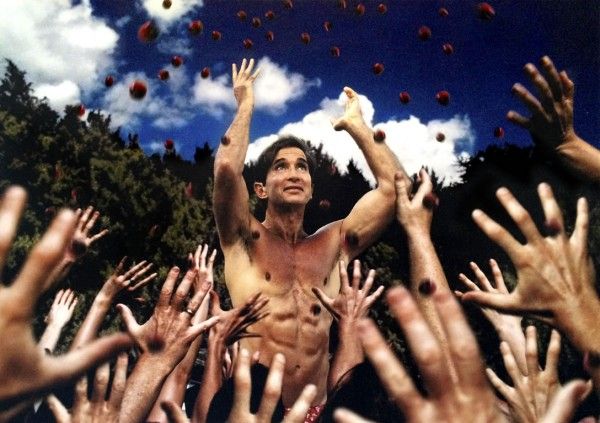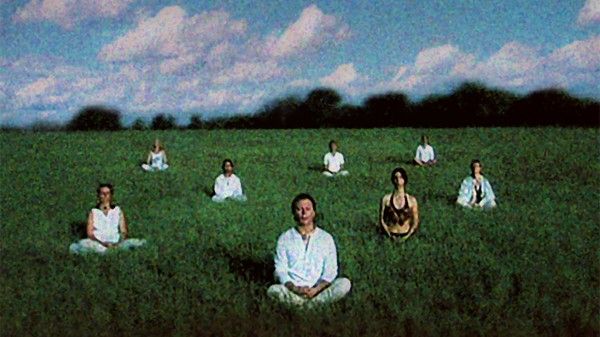Generally speaking, humans want to feel happy and like they’re part of a group, and cults feed on this desire. Cults are such an odd phenonemenon because they’re manifestation seems obvious to outsiders but insiders are completely oblivious. Cults distort reality, and Will Allen had a unique view to that distorted reality by spending 22 years with the Buddhafield cult and videotaping his experiences. He has now cut his footage together with interviews with former members into the documentary Holy Hell, which shows a textbook case of how a cult operates and follows a charismatic, dangerous leader. Allen goes in depth showing why Buddhafield was so enchanting and how it ultimately fell apart, and while the examination of its leader gets to be a bit tiresome, the documentary still carries us thanks to the compassion for those who survived.
Allen briefly shows us how his desire to learn about life and death led him to join his sister Amy in Los Angeles’ Buddhafield cult in 1985, and how at first everything was great. As one former member notes, they said in the early days, if it Buddhafield was a cult, it was a good cult to be in. They felt nothing but love and acceptance, they helped each other, and it was an ideal group. But as time wore on and the group’s leader, Michel, became more powerful and influential, the group deteriorated and abuse became more widespread. Eventually, a group once designed to serve everyone and give people enlightenment became a cult designed to serve Michel’s every need and desire.
Even though Allen made the movie and was one of Michel’s closest confidants (and victims), he doesn’t try to put himself ahead of other members. This isn’t Allen’s story with other interview subjects serving as background players. If anything, Allen tries to put himself on their level and almost seems reluctant to join the conversation. Even though his contributions are last, they don’t come off as the “last word”. He gives weight to other members and wants us to hear their stories and see the Buddhafield through their eyes as much as we see it through his footage.
This duality—acknowledging the damage the cult did to them individually while also knowing that it created an unbreakable bond between the good people within the community—lets Holy Hell stand apart from other documentaries about cults. We all know cults are damaging, and Michel definitely comes off as evil and twisted, but this isn’t like Going Clear minus the juicy Hollywood details. The inner workings of the Buddhafield aren’t spectacular—it’s Michel employing hypnosis sessions and Shakti—but how the members bought in is captivating and surprisingly moving.
It also helps that in the scheme of things, Buddhafield seems small scale. It meant a great deal to its members, so it has that gravity, but Holy Hell doesn’t carry the burden of being an “issue” movie even though Michel (now going under a new name in Hawaii) continues to operate a large cult of followers. It’s a movie about how cults transform and halt people, and the difficulties in discovering enlightenment and connection. Allen doesn’t ask everyone if they would do things differently if they had known how things would end with Buddhafield, but one member says he’s both angry and grateful. He’s angry that he served a psychopath like Michel but he’s both grateful for the relationships he made and the person it made him.
While it can be painful at times to watch these people relive their suffering, there’s an uplifting cathrarsis to Holy Hell, almost like it’s the last piece of a puzzle and rather than let the audience sit in judgment or mock the beliefs of those who participate, it lets us try to forge a bond with them instead.
Rating: B
Click here to catch up on all of our Sundance 2016 coverage thus far, and peruse our other reviews below.
- The Birth of a Nation
- Captain Fantastic
- Carnage Park
- Christine
- The Free World
- The Fundamentals of Caring
- Goat
- The Hollars
- Hunt for the Wilderpeople
- Indignation
- Love & Friendship
- The Lure
- Manchester by the Sea
- Morris from America
- Newtown
- Norman Lear: Just Another Version of You
- NUTS!
- Other People
- Sing Street
- Sleight
- Southside with You
- Swiss Army Man
- Under the Gun
- Under the Shadow
- Weiner



